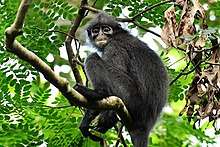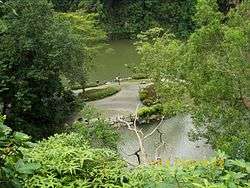Eco-Link@BKE
The Eco-Link@BKE is an ecological bridge in Singapore which connects the Bukit Timah Nature Reserve with the Central Catchment Nature Reserve.[1] The Eco-Link is 62 metres (203 ft) long and crosses over the Bukit Timah Expressway.[1][2] The bridge is shaped like an hourglass and at its narrowest point is 50 metres (160 ft) wide.[3] The Eco-Link is the first ecological bridge in Asia.[1][4] The Eco-Link@BKE is intended to aid in wildlife conservation efforts in Singapore.[1][2][3]
| Eco-Link@BKE | |
|---|---|
.jpg) | |
| Type | Ecological bridge |
| Operated by | National Parks Board, Government of Singapore |
| Status | In use |
| Website | www |
Purpose
Until the Bukit Timah Expressway was built in 1986, Bukit Timah Nature Reserve and Central Catchment Nature Reserve were connected.[2] The Bukit Timah Expressway severed the connection, leading to a number of negative impacts to the wildlife living in those reserves.[2] Animals who tried to cross the expressway to get from one reserve to the other were sometimes killed by oncoming cars.[2][3] For example, between 1994 and 2014, an average of two Sunda pangolins per year were killed in this manner, and the Sunda pangolin is critically endangered within Singapore with possibly as few as 50 left in the country.[2][3] The barrier to movement between the two reserves also inhibited seed dispersal, reducing plant biodiversity, and reduced the available space for animals such as the common palm civet to live in.[2] Also, by isolating populations of animals it reduced the genetic diversity of each population.[3] Eco-Link@BKE was intended to address these issues by creating a safe crossing between the reserves, and allowing expansion of the animals' habitats and gene pools.[1][2][3]
Construction
The first idea for the Eco-Link was in 1994, but plans for the Eco-Link were not announced until 2009.[2] Construction began in 2011 and the bridge was completed in 2013.[2] The Eco-Link cost more than S$10 million to build.[3][5] The bridge is covered with native vegetation, including trees and shrubs, which is intended to replicate a native forest ecosystem enticing to the animals.[2] There is a fence on the bridge to prevent certain large animals such as sambar deer and wild boar from crossing into Bukit Timah, which is too small and fragile to sustain them.[2] Camera traps and bat detectors are installed along the bridge to capture photos of animals crossing.[2][6]
Usage

Since the Eco-Link was completed, several animals species have been seen using it to cross from one reserve to the other. These include the Sunda pangolin, the common palm civet, the long-tailed macaque, the slender squirrel, the glossy horseshoe bat, the lesser Asiatic yellow bat, the pouched tomb bat, the blue-eared kingfisher and the emerald dove.[2][3][6] Between April 2014 and October 2015 no dead Pangolins were found near the Bukit Timah Expressway.[2] In 2016 a lesser mouse deer was seen in Bukit Timah.[3][6][7] It was believed to have used the Eco-Link since before that the species had only been seen in Central Catchment.[3][6][7] Authorities hope that when the trees mature, Raffles' banded langur monkeys will use the Eco-Link to expand their range into Bukit Timah.[2][3][7] Raffles' banded langur is critically endangered in Singapore, with only about 60 individuals remaining, and was eliminated from Bukit Timah in 1987.[2][8] Authorities also hope that the Malayan colugo and red-cheeked flying squirrel will begin using the Eco-Link once the trees mature.[2][3]
In late 2015 the National Parks Board began providing guided walking tours of the Eco-Link.[9] The walks continued through 2016 but were subsequently suspended to avoid potential disturbance to animals using the bridge.[9]
According to Singapore's Second Minister for National Development Desmond Lee, "It is reassuring that the bridge gives (animals) a better chance of survival, and, in fact, to flourish in this highly urbanised Singapore. Because Singapore is not just about concrete, or steel, or glass, or roads, or buildings, it is also about the green spaces that we work very hard and pro-actively to cherish, to protect, and more importantly, to enhance.”[7]
Future plans
Singapore has built a second Eco-Link structure, the Mandai Wildlife Bridge over Mandai Lake Road. Construction works commenced in June 2017, and the bridge opened on 6 December 2019. The bridge is 140 metres (460 ft) long and connects the vegetated areas of the Central Catchment Nature Reserve on either side of the road.[10][11][12]
References
- "Eco-Link@BKE". National Parks Board. Retrieved January 30, 2019.
- Min, Chew Hui & Pazos, Rebecca (December 11, 2015). "Animals Crossing". Straits Times. Retrieved January 30, 2019.CS1 maint: multiple names: authors list (link)
- Chen, Maxine (July 26, 2017). "How effective are wildlife corridors like Singapore's Eco-Link?". Conservation News. Retrieved January 30, 2019.
- "Man-made Corridors". Conservation Corridor. Retrieved January 31, 2019.
- "Construction Starts for Southeast Asia's First Ecological Corridor. Eco-Link@BKE to Link Two Nature Reserves across the Expressway". Land Transport Authority. July 30, 2011. Retrieved January 31, 2019.
- "Get to Know:Eco-Link@BKE". National Parks Board. Retrieved January 30, 2019.
- Lim, Stacey (November 4, 2015). "Nature-conservation bridge to open for guided tours". Mediacorp Press. Retrieved January 31, 2019.
- Ang A.; Srivasthan A.; Md.-Zain B.; Ismail M.; Meier R. (2012). "Low genetic variability in the recovering urban banded leaf monkey population of Singapore". Raffles Bulletin of Zoology. 60 (2): 589–594. Retrieved January 30, 2019.
- Tan, Audrey (August 11, 2017). "Guided walks on wildlife bridge spanning BKE to be stopped until further notice". Straits Times. Retrieved January 30, 2019.
- Tan, Audrey (July 27, 2017). "Mandai Eco-Link: All you need to know about the wildlife bridge". Straits Times. Retrieved January 30, 2019.
- Audrey Tan (November 6, 2019). "Wildlife bridge to help animals safely cross Mandai Lake Road will open in December". Retrieved February 8, 2020.
- Liu, Vanessa (December 6, 2019). "New wildlife bridge now open in Mandai - but it's animals only, please". The Straits Times. Retrieved May 24, 2020.
